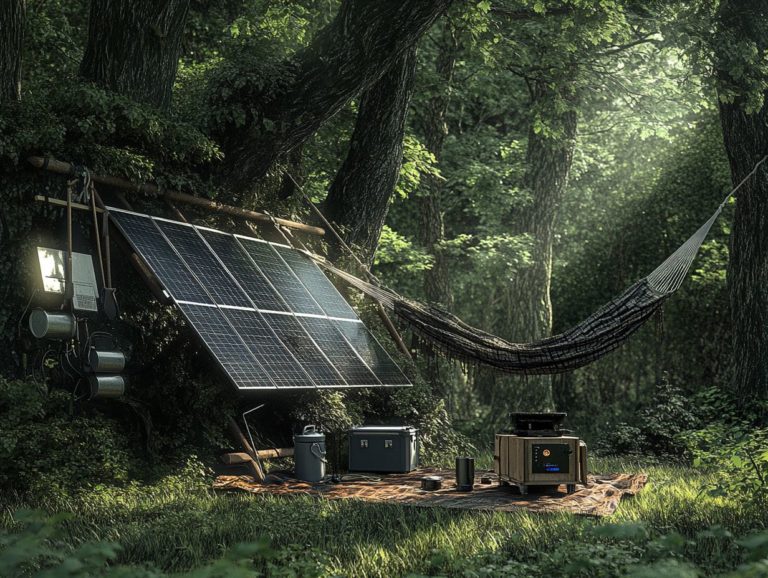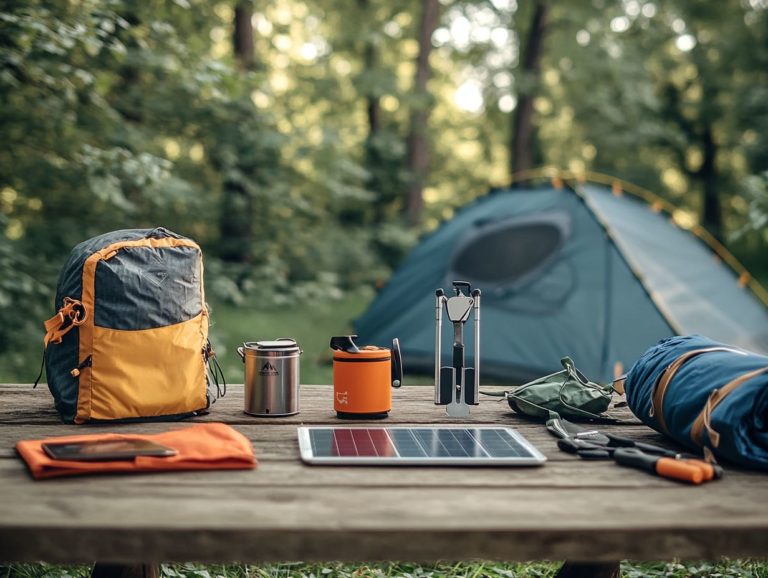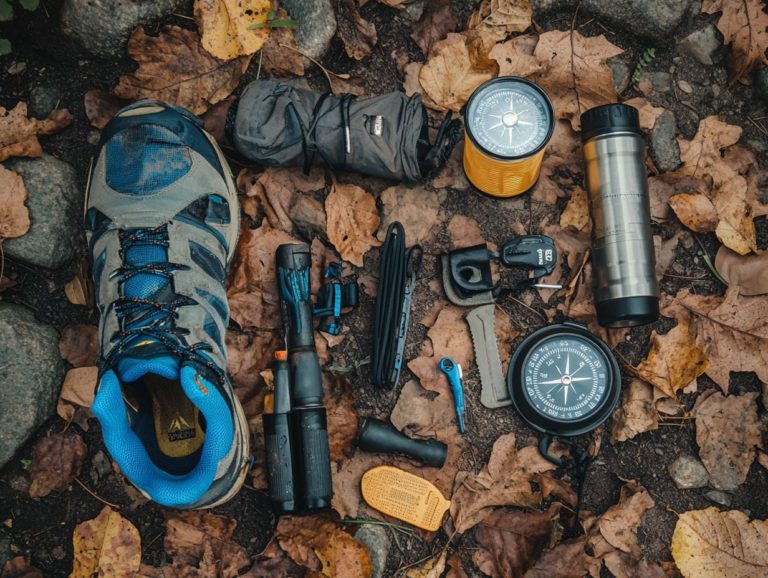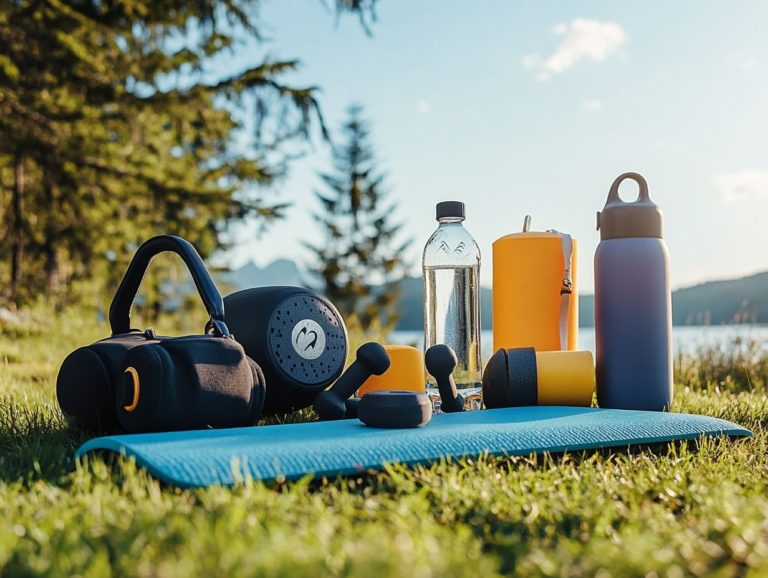Top Accessories for Winter Hiking
Winter hiking presents an exhilarating adventure where you experience serene landscapes and a strong connection to nature. To truly appreciate the beauty of this season, it s crucial to have the right gear at your disposal.
This article explores essential accessories for winter hikers, including insulated water bottles and waterproof gloves. You will also find tips for choosing the best items and avoiding common mistakes.
Equip yourself with the knowledge necessary to ensure your winter hikes are both safe and enjoyable!
Contents
- Key Takeaways:
- 1. Insulated Water Bottle
- 2. Hand and Toe Warmers
- 3. Headlamp
- 4. Hiking Poles
- 5. Winter Hiking Boots
- 6. Gaiters
- 7. Waterproof Gloves
- 8. Windproof Jacket
- 9. Thermal Base Layers
- 10. Wool Socks and Mittens
- 11. First Aid Kit
- 12. Emergency Blanket and Beanie
- 13. Navigation Tools
- 14. Portable Stove
- 15. Backpack with Proper Support, Insulation, and Day Pack
- What Are the Essential Items for Winter Hiking?
- Frequently Asked Questions
- What are the top accessories for winter hiking?
- How important are insulated boots for winter hiking?
- What type of gloves or mittens should I bring for winter hiking?
- Why is a warm hat or headband important for winter hiking?
- Do I need a water-resistant jacket or parka for winter hiking?
- What should I pack in my backpack for winter hiking?
Key Takeaways:
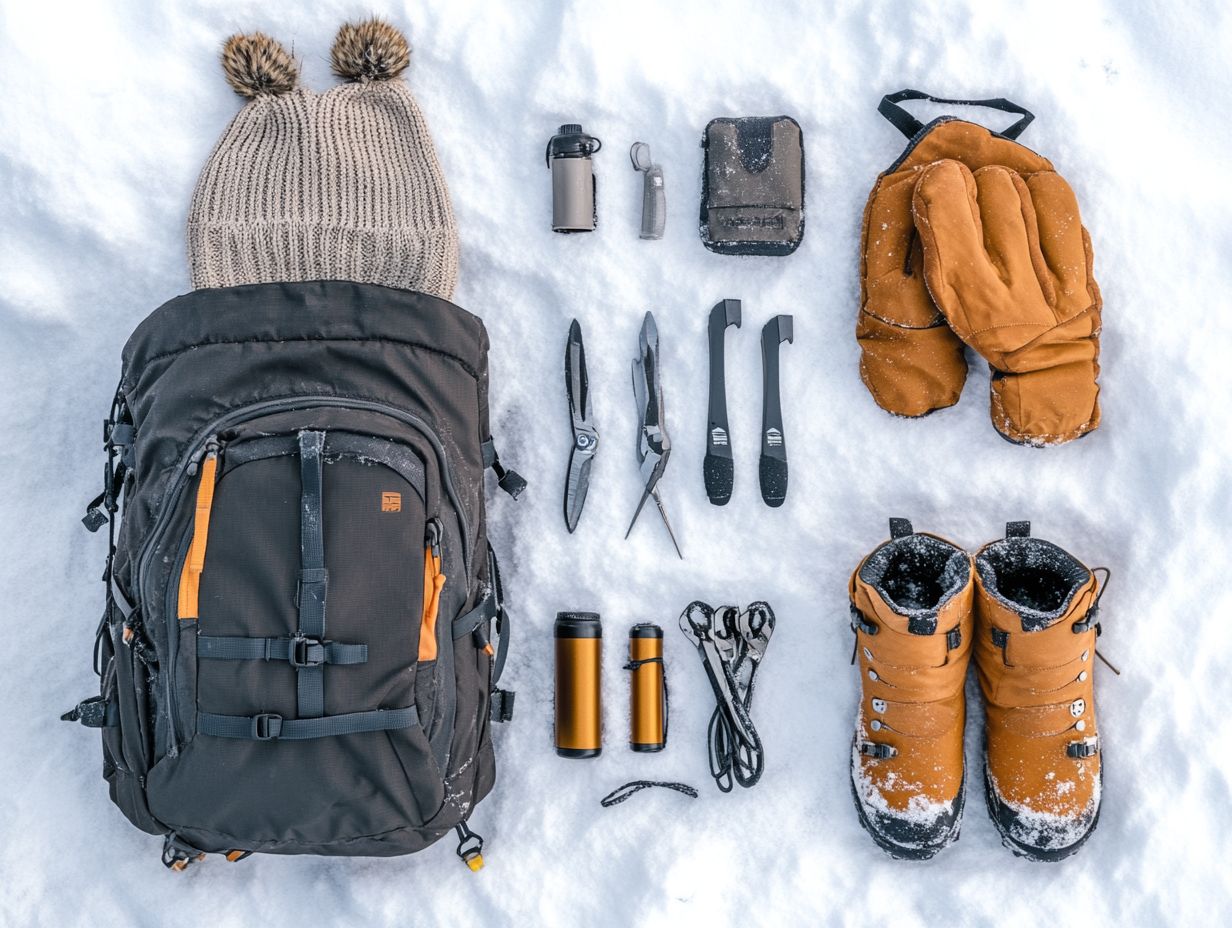
- Stay hydrated with an insulated water bottle.
- Keep warm with hand and toe warmers.
- Use a headlamp for safe navigation in low light.
1. Insulated Water Bottle
An insulated water bottle is truly a must-have for winter hiking, ensuring you stay hydrated as you traverse those chilly trails. These bottles are designed to keep your drinks hot or cold for a long time, preventing your drinks from freezing and helping you maintain optimal hydration throughout your adventure.
Consider brands like HydraPak, renowned for their special materials that keep your drinks at the right temperature be it comforting hot tea or refreshing cold water. The double-walled construction creates a protective barrier against the elements, allowing you to savor your drinks at the perfect temperature.
When selecting an insulated bottle, think about size and material. Smaller bottles are perfect for short hikes, while larger ones cater to full-day excursions. Opting for stainless steel models not only enhances durability but also provides resistance to the cold, making them a smart choice for anyone who enjoys winter outdoor activities.
2. Hand and Toe Warmers
Hand and toe warmers are essential companions for your winter hiking adventures, providing the crucial warmth and comfort your extremities need especially when the threat of frostbite looms. You have the luxury of choosing between disposable and rechargeable options, allowing you to select the perfect fit for your hiking style and personal preferences.
Disposable warmers are wonderfully convenient, activating with just a shake for one-time use, while rechargeable versions offer eco-friendly warmth that lasts across multiple outings. Selecting the right type can truly elevate your hiking experience, enabling longer treks and a deeper appreciation of the breathtaking winter landscapes. For maximum effectiveness, tuck those hand warmers inside your gloves or pockets, and position toe warmers beneath the ball of your foot or along your toes inside your footwear.
This ensures you stay blissfully warm as temperatures dip.
3. Headlamp
A reliable headlamp is an critical tool for your winter hiking adventures, providing hands-free illumination that allows you to navigate trails safely in low-light conditions. With this essential gear, you can explore the wilderness without compromising your safety.
When selecting a headlamp, consider key factors such as brightness levels, which typically range from about 100 to 1000 lumens. This range ensures you can adapt to various environments with ease. A long battery life is crucial for extended trips, so seek options that offer both rechargeable and disposable batteries. Water resistance is equally important, especially during winter excursions, as it guarantees functionality in snowy or wet conditions.
By investing in these features, you significantly enhance your safety, enabling you to spot potential hazards and navigate tricky paths effortlessly. By being well-prepared, you’ll dive right into the stunning winter landscape, making every moment of your hike thrilling and safe!
4. Hiking Poles
Hiking poles are crucial for enhancing your winter hikes. They provide stability on icy trails.
These tools also boost your endurance on long treks. They distribute weight evenly, helping to reduce fatigue.
You’ll find various trekking poles tailored to different needs. Adjustable lengths adapt to diverse terrains and user heights.
Crafted from lightweight materials like aluminum or carbon fiber, these poles are easy to carry without extra weight.
Some models include shock absorption systems, which reduce impact. This makes your hiking experience more comfortable, especially on downhill sections or rugged paths.
5. Winter Hiking Boots
Choosing the right winter hiking boots is key to your comfort and safety. The right pair can make your chilly adventures enjoyable!
These boots provide the necessary insulation, waterproofing, and traction to conquer snow-covered trails.
When selecting your boots, pay attention to insulation types. Materials like Thinsulate, a brand of insulation, or fleece can significantly enhance warmth without adding weight.
Waterproof materials like Gore-Tex are essential to keep your feet dry and warm, even in damp conditions.
Brands like Merrell and Columbia offer fantastic options, combining these features. Well-designed footwear helps retain body heat and enhances grip on slippery surfaces.
This ultimately boosts your hiking performance, allowing you to enjoy the beauty of the outdoors without distractions.
6. Gaiters
Gaiters are essential for your winter hiking adventures. They offer protection against snow and moisture while keeping your legs dry and warm on rugged terrain.
These protective garments come in various styles low, mid, and high tailored to meet different activity demands and conditions.
Common materials like nylon, polyester, and rubber create a waterproof barrier without sacrificing breathability. For warmer weather or lighter snow, low gaiters are perfect.
High gaiters provide maximum coverage against deep snow and mud.
Gaiters effectively seal the openings of your boots and pants, keeping out unwanted debris. This enhances comfort, allowing you to focus on the journey ahead.
7. Waterproof Gloves
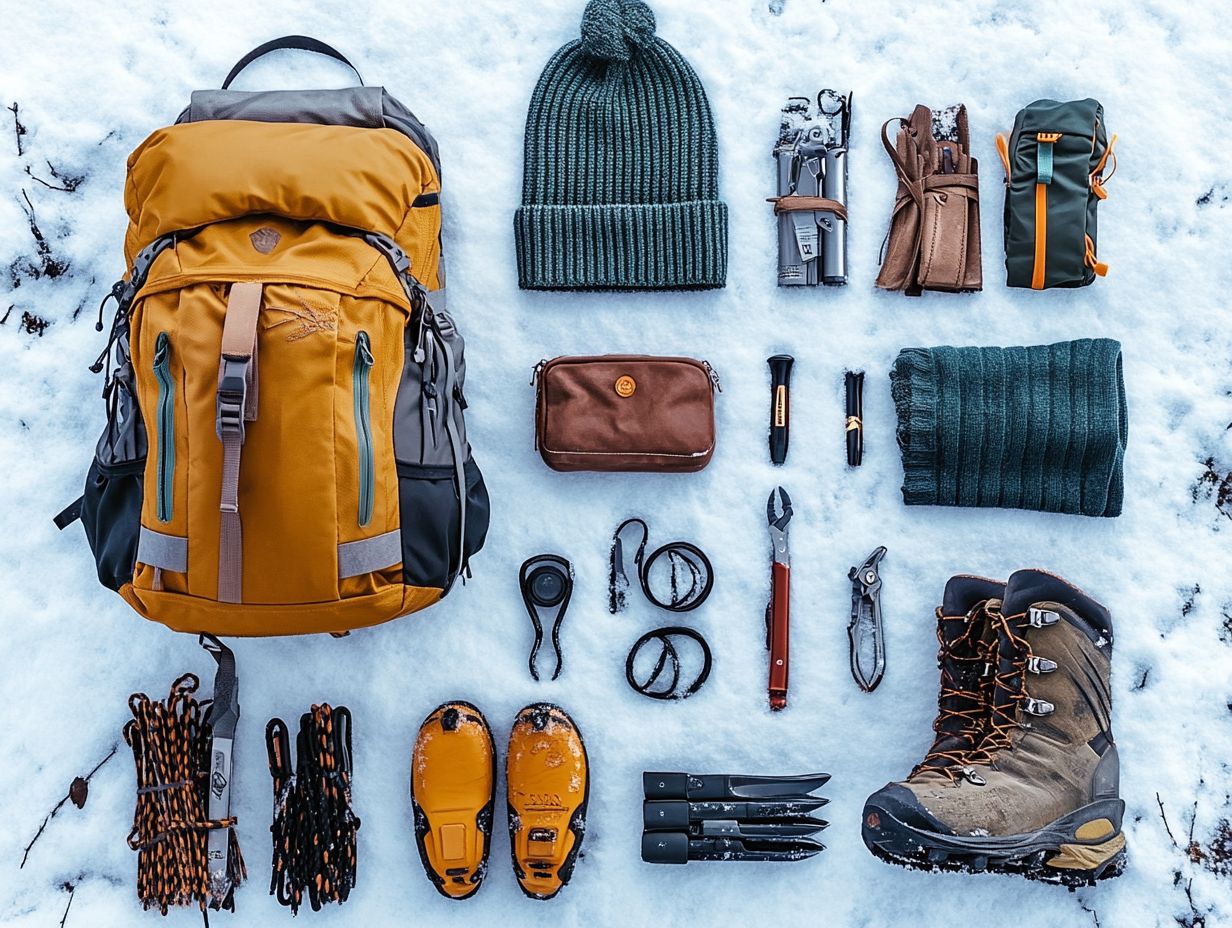
Waterproof gloves are essential for your winter hiking adventures. They protect against cold and moisture while allowing you to handle gear easily.
Selecting gloves with the right insulation and waterproofing is vital. These features enhance comfort and help prevent frostbite and hypothermia.
Renowned brands like Outdoor Research and Arcteryx offer high-quality options that use advanced materials and technology.
When choosing the perfect pair, take the time to try them on. You want flexibility without tightness.
Opt for styles with adjustable cuffs for a secure fit. This detail can significantly amplify warmth by keeping cold air and moisture out. Remember, well-fitted gloves can make all the difference in your outdoor adventures!
8. Windproof Jacket
A windproof jacket is an absolute necessity for your winter hiking adventures. It provides essential protection against biting winds while effectively retaining body heat. This significantly enhances your comfort on those chilly, gusty trails.
When selecting your windproof jacket, pay close attention to breathability. As a hiker, you need to stay dry from both external winds and the sweat generated during your trek. Opt for jackets that come with ventilation zippers or moisture-wicking fabrics. These features help facilitate airflow while still trapping warmth inside.
Layering is another critical factor to consider. A jacket that fits comfortably over or under other garments allows you to adapt to changing weather conditions with ease. Brands like Patagonia and Columbia are renowned for their high-quality cold-weather apparel. They offer durability and warmth without sacrificing style or functionality. Their commitment to sustainable materials is also commendable.
9. Thermal Base Layers
Thermal base layers are essential for your winter hiking adventures. They provide effective moisture-wicking and insulation to keep you warm and dry during those rigorous outdoor activities.
Crafted from an array of materials, these layers significantly elevate your comfort in cold conditions. For instance, Merino wool is celebrated for keeping you warm and managing moisture naturally. It offers a cozy feel without the itchiness typically associated with traditional wool.
Conversely, synthetic fabrics like polyester and nylon are prized for their durability and quick-drying capabilities. By strategically layering these materials, you can optimize heat retention. This leads to a more enjoyable and safer experience in the winter wilderness.
Striking the right balance in your layering not only shields you from the chill but also aids in managing sweat, reducing the risk of hypothermia.
10. Wool Socks and Mittens
Wool socks are the ultimate choice for your winter hiking adventures. They offer exceptional moisture-wicking properties, warmth, and comfort everything you need to keep those toes cozy during long treks on snowy trails.
When you compare them to cotton or synthetic options, wool provides a remarkable blend of insulation and breathability. This ensures your feet stay warm without overheating. Brands like Smartwool and Darn Tough truly set the standard, crafting socks that excel in thermal management while showcasing impressive durability.
These high-quality wool fibers are engineered to endure the challenges of cold weather and rugged terrains. This delivers performance you can trust, resulting in fewer replacements and more time for the adventures you love. You can focus on the journey rather than any nagging foot discomfort.
11. First Aid Kit
A well-stocked first aid kit is your essential companion for winter hiking. It provides crucial supplies to tackle injuries and emergencies that might arise during your cold-weather adventures. Being prepared means you can fully enjoy your winter hikes without worry!
Regarding common winter-related injuries think frostbite, hypothermia, or those pesky slips and falls on icy paths having the right materials at your fingertips can truly make all the difference. Essential items to include in your kit are:
- Warm pack wraps – Great for providing immediate warmth.
- A thermal blanket – Essential for retaining body heat in emergencies.
- Antiseptic wipes – Important for cleaning wounds and preventing infections.
- Adhesive bandages – Useful for covering minor cuts and scrapes.
- Gauze for managing cuts and scrapes – Crucial for more serious injuries.
But remember, knowing how to use these supplies effectively is just as vital as having them. Basic first aid knowledge gives you the power to respond swiftly, preventing minor issues from escalating into serious problems. This confidence allows you to immerse yourself in the stunning beauty of winter landscapes without worry.
Don’t head into the winter wilderness without it! What are your must-have items for winter hiking?
12. Emergency Blanket and Beanie
An emergency blanket is an essential accessory for your winter hiking excursions, offering vital warmth and protection in unexpected scenarios. It ensures you remain warm while waiting for rescue or recovering from an injury.
These lightweight, compact blankets are typically crafted from reflective material, designed to efficiently retain your body heat. You ll find various options available, including those with extra insulation for the harshest conditions and multi-functional versions that can double as shelters or ground covers.
Incorporating one into your hiking pack is crucial hypothermia can set in surprisingly quickly if temperatures drop more than you expected. Whether you’re navigating s snowy peaks or meandering through wooded trails, having this lifesaving gear at your disposal can truly make all the difference, providing you with peace of mind as you embrace your adventures. Don’t head out without one; it could save your life!
Effective navigation tools are crucial for your winter hiking adventures, enabling you to safely explore remote trails without the risk of getting lost in those enchanting yet treacherous snow-covered landscapes.
From traditional maps and compasses to cutting-edge GPS devices, these tools are essential for guiding you through difficult trails. A well-detailed map can offer vital information about elevation changes, water sources, and landmarks, giving you the power to plan your routes with precision.
Compasses, on the other hand, remain invaluable for honing your navigational skills, providing a dependable method for orienting yourself in unfamiliar territories. GPS devices have transformed navigation, displaying your precise location in real-time, which simplifies tracking your progress and locating trails.
These navigation aids enhance your hiking experience and improve your safety, helping you stay aware of your surroundings and steer clear of potential hazards.
14. Portable Stove

A portable stove is an essential companion for your winter hiking adventures, enabling you to whip up warm meals and beverages that can elevate your outdoor experience and help you maintain body heat during those chilly excursions.
Imagine pausing to savor hot soup during a well-deserved break or indulging in a comforting plate of pasta after a long trek having the right stove truly transforms the experience.
When choosing a portable stove, consider options such as compact gas stoves, multi-fuel stoves, and wood-burning models, each presenting unique advantages in cold conditions. Gas stoves are known for their quick heating and user-friendly design, while multi-fuel stoves offer the flexibility of various fuel sources.
As you hike, don t overlook the significance of cooking; it not only replenishes your energy but also lifts your spirits, turning each meal into a cherished moment of warmth and comfort amid the icy wilderness.
15. Backpack with Proper Support, Insulation, and Day Pack
A well-designed backpack with the right support and insulation, including a versatile day pack, is essential for your winter hiking adventures. It ensures that you can comfortably carry all your essential gear while staying warm and having easy access to everything you need in the cold.
When selecting the perfect winter hiking backpack, you should pay attention to several key features. Look for adjustable support systems that provide stability and distribute weight effectively, making those long treks easier on your back.
Insulated compartments are also a must; they help keep your food and water from freezing, which is critical in frigid conditions, especially when using HydraPak, a popular hydration system that keeps your water accessible on the go.
Consider storage options as well. Multiple pockets and attachment points make organization a breeze and allow for quick access to your gear. Brands like Deuter and MSR offer a variety of models that emphasize these essential features. To enhance your hiking experience, check out essential accessories for hiking, specifically designed to meet the unique demands of winter hikers and ensure your outing in the snow is a resounding success.
What Are the Essential Items for Winter Hiking?
When it comes to winter hiking, equip yourself with essential items that enhance both safety and comfort. Think of insulated water bottles, waterproof boots, thermal base layers, and other accessories tailored to face the unique challenges of cold-weather adventures.
Preparation is key for a successful outing. Winter conditions can change suddenly, making the right gear critical for staying warm and mobile. Take a high-quality insulated water bottle; for example, it’s a game changer for hydration, keeping your liquids from freezing when temperatures drop. Additionally, knowing the best practices for winter hiking can enhance your experience. Waterproof boots from trusted brands like Salomon or Merrell are equally important, providing the traction and protection necessary for navigating snowy or icy trails.
Don’t overlook thermal base layers, such as those offered by Smartwool. They provide essential warmth while efficiently wicking away sweat, helping you maintain a comfortable temperature. Additionally, consider essential winter hiking gear like trekking poles for stability and gloves or mittens to protect your extremities, which will significantly enhance your overall winter hiking experience.
How Can These Accessories Enhance the Winter Hiking Experience?
Winter hiking accessories are crafted to elevate your outdoor experience, ensuring you enjoy every moment in nature, even in frigid temperatures.
Among these essentials, waterproof gloves are a must-have investment. They keep your hands dry and warm vital for maintaining dexterity during brisk hikes. Thermal base layers also provide exceptional warmth, allowing your body heat to be retained while moisture escapes, preventing that uncomfortable chill caused by perspiration.
When you gear up with the right equipment, you enhance your personal comfort and reduce the risks associated with harsh conditions. The proper accessories can turn a potentially uncomfortable trek into an unforgettable adventure, transforming each step across snowy trails into a pleasure rather than a chore.
What Are Some Tips for Choosing the Right Winter Hiking Accessories?
Choosing the right winter hiking accessories requires careful thought about functionality, materials, and your personal needs. It s essential to select gear that truly supports your outdoor adventures in the cold.
Pay attention to how well items fit, their warmth, and their ability to endure harsh weather conditions. Properly fitted gloves and boots are vital for maintaining warmth and dexterity, while jackets should provide excellent insulation without sacrificing breathability.
Look for reputable brands like:
- The North Face for reliable outerwear
- Smartwool for top-notch base layers
And don t overlook essential accessories such as:
- Buff for versatile neck gaiters
- Gaiters from Outdoor Research to keep snow out of your boots
Both of these options excel in winter adventures, ensuring you re well-equipped for whatever the cold throws your way.
How Can One Prepare for Winter Hiking in Terms of Gear?
Preparing for winter hiking means assembling essential gear that ensures safety and comfort while addressing the unique challenges of cold-weather environments. Remember, preparation isn t just about packing it s about being ready for anything!
You’ll want moisture-wicking clothing layers that provide warmth, along with critical accessories like gloves and hats to shield your extremities from the biting cold. Additionally, consider essential hiking gear accessories such as headlamps, first aid kits, and navigation tools, which become crucial when venturing into snowy terrains where visibility may dwindle and conditions can shift instantly.
Don t forget to test your gear this could be the difference between a great adventure and a challenging one! Ensure that every component works seamlessly, from zippers and buckles to the batteries in your headlamp. Wearing boots that don t fit right or forgetting essential layers can lead to disaster on the trail. By confirming that everything is in tip-top shape beforehand, you significantly lessen the risk of discomfort and hazards during your adventure.
Taking the time to fine-tune your equipment not only elevates your experience but also boosts your confidence to tackle the exhilarating challenges that winter hiking presents.
Get ready for your adventure by ensuring you have the right gear!
What Are Some Common Mistakes to Avoid When Choosing Winter Hiking Accessories?
Avoid these mistakes to ensure a safe and enjoyable adventure! When selecting winter hiking accessories, steer clear of picking the wrong size, overlooking insulation needs, or ignoring the specific weather conditions you might encounter on the trail.
Many hikers underestimate the power of layering. Remember, wearing cotton can trap moisture and leave you feeling chilled. Opting for synthetic or merino wool fabrics will keep you dry and insulated.
It s also crucial to know the trail conditions, as temperatures can drop significantly in shaded areas or during windy spells. Don t overlook proper traction devices. They can be game-changers on icy surfaces.
By taking the time to understand these elements and prepare thoughtfully, you can elevate both your safety and enjoyment as you navigate the winter trails.
Frequently Asked Questions
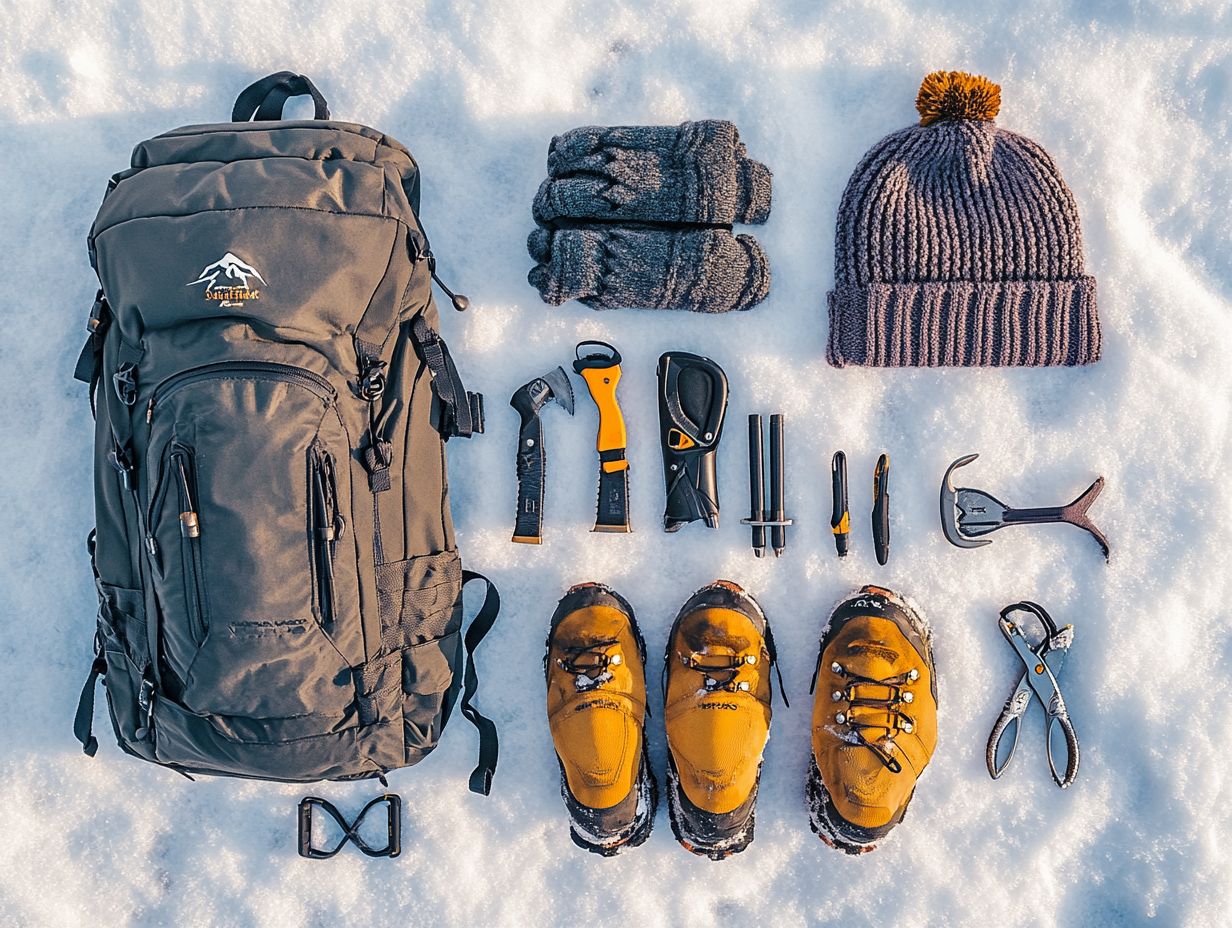
What are the top accessories for winter hiking?
The top accessories for winter hiking include insulated boots, warm socks, gloves or mittens, a warm hat or headband, a water-resistant jacket or parka, and a backpack to carry essentials.
How important are insulated boots for winter hiking?
Insulated boots are crucial for winter hiking. They keep your feet warm and dry, preventing frostbite and hypothermia. Look for boots with at least 200g of insulation and a waterproof outer layer.
What type of gloves or mittens should I bring for winter hiking?
Choose gloves or mittens that are waterproof and insulated to keep your hands warm. Having touchscreen-compatible gloves is also helpful so you can use your phone without taking them off.
Why is a warm hat or headband important for winter hiking?
Most of your body heat escapes through your head, so wearing a warm hat or headband is crucial for staying warm during winter hiking. Look for hats made of wool or fleece for the best insulation.
Do I need a water-resistant jacket or parka for winter hiking?
Absolutely! A water-resistant jacket is key to staying dry and warm in winter conditions. Look for one with a hood and adjustable cuffs to keep out the elements.
What should I pack in my backpack for winter hiking?
In addition to the necessary clothing and accessories, pack a map and compass, first aid kit, snacks, water, a flashlight, and a small emergency shelter for unexpected conditions or emergencies.
Gear up with the right accessories and hit those winter trails confidently!

